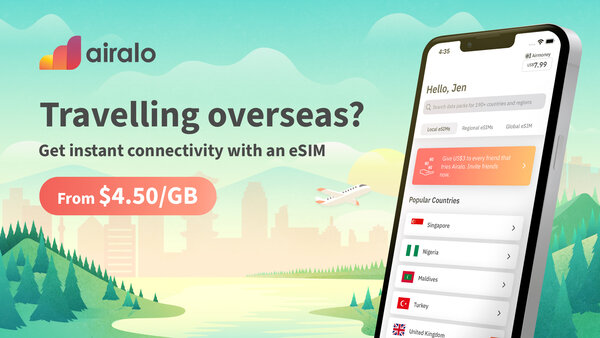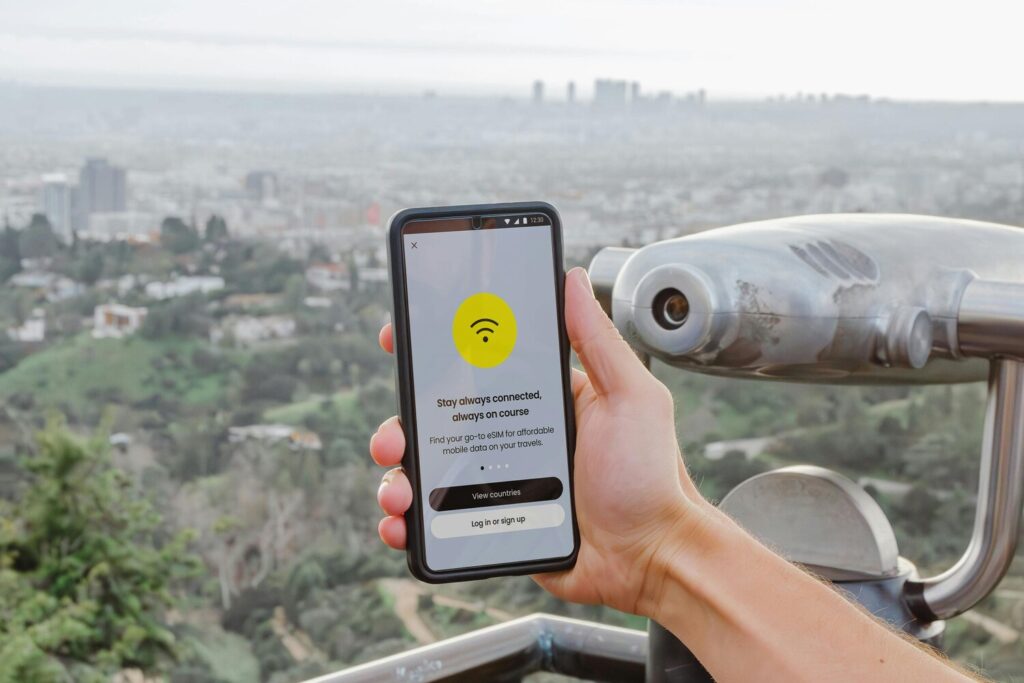
Best eSIMS for Japan
If you’re planning a trip to Japan, staying connected is essential – whether it’s for navigating Tokyo’s neon-lit streets, using translation apps, or sharing your sushi feast on social media. That’s where eSIMs come in.
An eSIM (embedded SIM) is a digital SIM that lets you connect to a mobile network without needing a physical SIM card as we did back in the day. It’s a game-changer for travelers, especially in Japan, where buying a local SIM card can be tricky due to registration rules and language barriers. With an eSIM, you can activate a plan before you even land in Japan, so you’re online the moment you step off the plane – convenience at its finest.
The perks? First, no more hunting for a SIM card or dealing with tiny trays and ejector tools (because who actually keeps those darn things?). Nowadays, you just scan a QR code, and you’re good to go.
Plus, many eSIM providers offer affordable data plans tailored for travelers, generally way cheaper than international roaming from your home carrier. Another bonus is that eSIMs let you store multiple profiles, meaning you can keep your regular number while using a local data plan for Japan – no stressing about keeping your primary SIM safe.
The nice thing is that Japan’s mobile networks are fast, reliable, and widely covered, and nowadays, more carriers support eSIM technology. So, whether you’re exploring Kyoto’s temples, skiing in Hokkaido, or riding the Shinkansen at lightning speed, an eSIM ensures that you can stay connected without spending lots of money.
We’re going to dive into the best eSIM cards for Japan, comparing coverage, pricing, and ease of use so that you can focus on the fun parts of planning your holiday and enjoying the actual trip without stressing about logistics.
How Do eSIMS Work In Japan?
So, normally, with a traditional SIM, you’d have a physical card that is inserted into your phone. But, an eSIM is built into he device, so instead of having to buy the thing and put it in, all you have to do is download a mobile plan digitally – no fuss, no hunting for SIM card vending machines at the airport or struggling with activation at a store.
Activating an eSIM card for Japan is incredibly simple. Most providers will send you a QR code after the purchase. Just scan it in your phone’s settings, follow the prompts, and you’ll be online in minutes. Some services allow manual installation, where you enter network details yourself, and others let you activate through a dedicated carrier app. And the best part is that you can do all of this before you even land in Japan, so you won’t have to spend even a minute without connectivity.
Before you buy an eSIM, it’s important to check that your device is actually compatible, because not all cellphones are.
Most modern smartphones, including iPhone XS and later, Google Pixel 4+, and Samsung Galaxy S20+ and newer, support eSIMs, and some phones even offer dual SIM capabilities, meaning you can keep your home number active for calls and texts while using your eSIM for high-speed local data.
Japan, being the tech-savvy nation that it is, has excellent mobile coverage, and major carriers like NTT Docomo, SoftBank, and au (KDDI) all support eSIM technology.
Whether you’re using maps to navigate Tokyo, streaming Netflix on a bullet train to Osaka, or handling work emails from a Kyoto café, an eSIM ensures seamless, high-speed internet access – without the faffing around with a physical SIM card.
Advantages of Using eSIMS for Travel in Japan
Traveling to Japan is an adventure for so many reasons – you could be slurping ramen in Tokyo, snapping cherry blossom pics in Kyoto, or getting lost in the streets full of culture, color, and intrigue. But one thing you don’t want to get lost? Your internet connection. That’s where eSIMs save the day – here’s why.
Super Convenient: No Tiny SIM Cards to Fumble With
Let’s be real, swapping SIM cards is a pain. Who wants to dig out a paperclip (or worse, risk using an earring, because we’ve all done that) to eject a SIM tray?
With an eSIM, there’s nothing to swap, lose, or misplace. You just download a mobile plan, activate it in minutes, and you’re online. Perfect for when you land in Narita or Haneda and need directions to your hotel ASAP.
Save Money: No More Outrageous Roaming Fees
International roaming charges can be brutal – we’ve all heard the horror stories. If you forget to turn off data roaming, your home carrier might hit you with fees that cost more than your entire sushi budget – like, for life.
eSIMs offer affordable local data plans, often much cheaper than paying your carrier’s international rates. Plus, Japan has fantastic mobile coverage, so you’re getting fast speeds without breaking the bank – top-quality convenience, Japan’s specialty.
Multiple eSIM Profiles: Because One Plan is Never Enough
Japan might be your main destination, but what if you’re also hopping over to Korea or Taiwan? No problem. eSIMs let you store multiple plans on one device. You can switch between different networks in seconds, making them perfect for multi-country travelers. No need to carry multiple SIM cards or worry about losing them in your luggage!
Instant Activation: Because Who Has Time to Wait?
One of the biggest perks of an eSIM is that you don’t have to wait until you get to Japan to buy it and set it up. Rather, you can buy it and activate it on the go. No need to search for a SIM card kiosk at the airport or wait in line at a store. Just scan a QR code, follow a few steps, and you’re online in minutes.
Security and Reliability: No Lost SIMs, Way Less Stress
Japan is one of the safest countries in the world, but losing a physical SIM card is still a hassle you don’t want – and let’s be honest, the likelihood of this happening is so high.
With an eSIM, there’s nothing to misplace. No tiny chip that can fall out of your wallet, no need to store a backup. Plus, Japan’s top-tier mobile networks (NTT Docomo, SoftBank, and au) ensure reliable, high-speed coverage wherever you go.
With an eSIM, staying connected in Japan is easy, affordable, and stress-free, giving you more time to explore the destination, see cool things, and eat all of the delicious food.
Key Factors to Consider When Choosing the best eSIM Provider in Japan
It may be tempting to just go all in on the first plan you see, but trust us, it’s not worth it. Because ultimately, eSIMs as well as their providers and packages are all different, varying in terms of coverage, speed, and value for your trip.
Here are some of the most important things to be aware of when you’re choosing an eSIM provider in Japan.
Coverage: Are You Sticking to Japan or Traveling Beyond?
Some eSIM providers offer Japan-only plans, while others cover multiple countries in Asia or even global travel. Of course, if Japan is your only stop, then the former is perfect, ad you’ll want a provider that connects to major local networks like NTT Docomo, SoftBank, or au (KDDI) for the best speed and reliability.
But, if you’re also visiting South Korea, Taiwan, or beyond, consider an Asia-wide eSIM to avoid switching plans. Why? Because there are options that are just as easy and affordable to get your hands on that’ll reduce the hassle tenfold.
Data Plans and Pricing: Pay-as-You-Go, Unlimited, or Fixed?
Japan has some of the fastest mobile networks in the world, so you’ll want a plan that suits your data needs. Some providers offer pay-as-you-go options, while others have unlimited data for a set number of days, which is great if you’re streaming, video calling, or using navigation all day.
Fixed data plans (like 5GB for 15 days) can be cheaper if you’re a light user – for instance, if you’re just planning on checking messages periodically or jumping onto Google Maps if you get lost.
But, whatever the case may be, always compare prices and see if the provider charges extra for hotspot usage, because this can be a bit annoying.
Speed and Network Quality: 4G or 5G?
Most eSIM providers in Japan offer 4G LTE, but if you have a 5G-compatible phone and want blazing internet speeds (who knows, perhaps you’re a big deal influencer), check if your provider supports 5G access.
Japan’s 5G network is expanding fast, and if you’re planning to upload a ton of high-res sushi pics or stream Netflix on the Shinkansen, you’ll appreciate the extra speed. And what better place in the world to prioritise top-notch internet speed?
Device Compatibility: Will Your Phone Even Work?
Probably the most important thing to consider is that not all phones actually support eSIMs, so before you buy a plan, make sure your device is compatible.
Apple users are in luck – eSIM works on iPhone XS and newer models, including the iPhone 14 and 15 series. For Android, Google Pixel 4+, Samsung Galaxy S20+, and newer flagship models mostly support eSIMs.
But, if you’re unsure, just check your phone settings under “Mobile Data” or “Cellular” to see if there’s an “Add eSIM” option. If you don’t see that, it’s probably bad news.
Validity and Expiration: How Long Will Your eSIM Last?
Each eSIM provider has different rules on how long their plans stay active. Some eSIMs last just a week, while others can be used for 30 days or more. So whatever option you go with, make sure you read the fine print.
If you’re staying in Japan for an extended period of time, check whether your eSIM can be recharged or extended. The last thing you want is to lose service in the middle of your trip!
Customer Support and App Experience: Is It Easy to Use?
Some eSIMs activate instantly and have user-friendly apps for tracking data usage, while others require manual setup. So, before you start buying, check if the provider offers 24/7 customer support in case something goes wrong. Japan’s time zone may not match your home country, so having round-the-clock help can be a lifesaver if you run into issues. You definitely don’t want to wait hours to get some assistance!
Top 10 Best eSIM Providers for Travel in Japan
Now that you know some of the most important factors to consider when picking your eSIM provider, here are the top 10 best eSIMs for Japan.
1. Airalo – Best for Global Travelers
Airalo is one of the most well-known eSIM providers in the world, offering affordable plans in over 190+ countries. Their Japan-specific eSIM connects to top networks like NTT Docomo, ensuring strong coverage nationwide.
- Coverage: Japan + global plans available
- Pricing: Starts at $4.50 for 1GB (7 days), up to $26 for 10GB (30 days)
- Speed and Network: 4G LTE on NTT Docomo
- Best For: Frequent flyers, digital nomads, and budget-conscious travelers
Pros:
- Affordable and widely available
- Easy activation via the Airalo app
- Can top up your data without reinstalling the eSIM
Cons:
- No unlimited data options
- No phone number for calls/SMS
2. Nomad: Best for Regional Flexibility
Nomad offers flexible Japan-only and Asia-wide eSIM plans, making it a great option if you’re hopping between Japan, Korea, and other nearby countries.
- Coverage: Japan + regional plans for Asia, Europe, and North America
- Pricing: $5 for 1GB (7 days), $26 for 10GB (30 days)
- Speed and Network: 4G LTE (no 5G yet)
- Best For: Multi-country travelers, budget-conscious explorers
Pros:
- No hidden fees, you only pay for what you use
- Easy setup with QR code activation
- Competitive pricing for short trips
Cons:
- No 5G support yet
- No unlimited data options
Holafly: Best for Unlimited Data Plans
Holafly is perfect if you burn through data fast – they offer unlimited plans for Japan, so you can stream, browse, and video call without worrying about running out.
- Coverage: Japan only (no regional/global plans)
- Pricing: $19 for 5 days, $47 for 15 days (all unlimited data)
- Speed and Network: 4G LTE, but speed may slow after heavy usage
- Best For: Data-hungry travelers, streamers, and remote workers
Pros:
- Truly unlimited data
- Super easy activation
- No need to worry about data top-ups
Cons:
- No hotspot/tethering allowed
- Can be pricier for long trips
GigSky: Best for Business Travelers
GigSky provides high-quality network coverage and reliable speeds, making it a great choice for business travelers who need stable internet for work calls and emails.
- Coverage: Japan + over 125 countries worldwide
- Pricing: $10 for 1GB (7 days), $50 for 5GB (30 days)
- Speed and Network: 4G LTE
- Best For: Business travelers, professionals on the go
Pros:
- Reliable, high-speed connection
- Simple app-based activation
- Works well for international business trips
Cons:
- No unlimited data plans
- A bit more expensive than competitors
Truphone: Best for Seamless Activation
Truphone offers a smooth, user-friendly activation process, perfect if you don’t want to mess with complicated setup instructions.
- Coverage: Japan + 89+ countries worldwide
- Pricing: $6 for 1GB (7 days), $35 for 5GB (30 days)
- Speed & Network: 4G LTE, solid connection in cities
- Best For: Casual travelers, first-time eSIM users
Pros:
- Super easy activation
- No hidden fees or expiration surprises
- Works across multiple regions
Cons:
- Limited data plan options
- No 5G support
Ubigi: Best for Long-Term Travelers
If you’re planning an extended stay in Japan, Ubigi offers monthly data plans that are more cost-effective than short-term eSIMs.
- Coverage: Japan + global plans
- Pricing: $12 for 3GB (30 days), $32 for 10GB (30 days)
- Speed & Network: 4G LTE, some 5G availability
- Best For: Long-term travelers, expats, remote workers
Pros:
- Cost-effective for longer stays
- Some plans offer 5G access
- Works in multiple countries
Cons:
- No unlimited data plans
- Slower speeds in rural areas
Simtex: Best for Affordable Data in Asia
Simtex is one of the cheapest options for Japan, with low-cost data plans that still connect to major networks.
- Coverage: Japan and other Asian countries
- Pricing: $4 for 1GB (7 days), $15 for 5GB (30 days)
- Speed and Network: 4G LTE
- Best For: Budget travelers, backpackers
Pros:
- Very affordable plans
- Easy online purchase and activation
- Works in multiple Asian countries
Cons:
- No 5G support
- Fewer plan options than competitors
KnowRoaming: Best for Frequent Travelers
KnowRoaming is ideal for travelers who are constantly on the move, offering flexible pay-as-you-go options.
- Coverage: Japan + 200+ countries
- Pricing: Varies by country and data usage
- Speed and Network: 4G LTE
- Best For: Frequent flyers, global nomads
Pros:
- Flexible pay-as-you-go plans
- Works worldwide
- Great for multi-country trips
Cons:
- Pricing can be unpredictable
- No unlimited data options
BNESIM: Best for Flexible Pay-as-You-Go Plans
BNESIM lets you customize your data plan to fit your needs, making it great for those who want complete control over their usage.
- Coverage: Japan + 170+ countries
- Pricing: Fully customizable pay-as-you-go plans
- Speed and Network: 4G LTE
- Best For: Travelers who want control over their data spending
Pros:
- Fully customizable plans
- No hidden fees
- Works globally
Cons:
- Can be confusing to set up
- No unlimited data
Flexiroam: Best for Multi-Country Travel
If you’re country-hopping around Asia, Flexiroam is a solid choice with regional data plans that work across multiple locations.
- Coverage: Japan and Asia, Europe, and more
- Pricing: $10 for 1GB (7 days), $50 for 10GB (30 days)
- Speed and Network: 4G LTE
- Best For: Travelers visiting multiple countries in one trip
Pros:
- Great for multi-country travel
- Easy-to-use app
- Affordable pricing
Cons:
- No unlimited plans
- No 5G support
How to Set Up an eSIM for International Travel to Japan
Setting up an eSIM for Japan is way easier than dealing with physical SIM cards. All you have to do is just follow these simple steps, and you’ll be connected as soon as you land in Tokyo, Osaka, or wherever your adventure takes you.
Step 1: Check if Your Phone Supports eSIM
Not all phones are eSIM-compatible, so before you buy a plan, make sure your device supports it. As we said, generally, newer iPhones (XR and later) and many Android flagships (Samsung Galaxy S20+, Google Pixel 3+, etc.) have eSIM functionality. If you’re unsure, check your phone’s settings:
- On iPhone: Go to Settings > Cellular > Add Cellular Plan. If you see this option, you’re good to go!
- On Android: Look under Settings > Connections > SIM Manager or search for “eSIM” in your phone’s settings.
Step 2: Choose an eSIM Provider for Japan
Not all eSIMs are the same or offer the same things. Some offer unlimited data, while others have pay-as-you-go options, so make sure you pick one based on your needs:
- Need unlimited data? Go for Holafly.
- On a budget? Try Simtex or Airalo.
- Multi-country traveler? Check out Flexiroam or Nomad.
Step 3: Buy a Plan and Get Your QR Code
Once you’ve chosen a provider, head to their website or app, select a Japan-specific plan, and complete your purchase. After you’ve made the payment, you’ll receive a QR code via email or directly in the app.
Step 4: Scan the QR Code to Install the eSIM
Now comes the fun part – activating your eSIM!
- Go to your phone’s settings
- Select Cellular (iPhone) or SIM Manager (Android)
- Tap Add Cellular Plan
- Scan the QR code you received from your eSIM provider
- Follow the on-screen instructions to complete the installation
Some providers also allow manual installation using activation details instead of a QR code, but scanning is way easier.
Step 5: Set the eSIM as Your Primary Data Provider
After installing the eSIM, make sure your phone actually uses it for data instead of your home SIM:
- On iPhone: Go to Settings > Cellular > Default for Data and select your new eSIM.
- On Android: Head to SIM Manager and set your eSIM as the default data SIM.
If you’re keeping your home SIM active for texts or calls, be sure to turn off data roaming to avoid surprise charges.
Step 6: Test Connectivity Before You Depart
Before you even pack your bags, test the eSIM at home (if your provider allows pre-activation). If you do this, you’ll be able to ensure that the installation worked, your phone recognizes the eSIM, and there are no last-minute issues when you arrive in Japan.
If your eSIM plan only activates upon arrival, that’s okay. Just make sure you have Wi-Fi at the airport or your hotel to troubleshoot if needed.
eSIM vs. Local Sim vs. Roaming: What’s the Best Choice When You’re Traveling In Japan?
It’s generally understood that when you’re traveling and need connectivity, you have three main options: eSIM, local SIM, or roaming. Each has its advantages and drawbacks, so let’s break it down with Japan-specific details.
Cost
- eSIM: Generally more affordable than roaming since it avoids the high international charges that traditional carriers impose. eSIM providers offer competitive pricing, and while unlimited data plans are rare, you can still find affordable options with generous data allowances.
- Local SIM: Often the cheapest choice, especially for longer stays. But, you’ll need to physically buy and insert a new SIM card, which means you won’t have immediate connectivity upon landing.
- Roaming: By far the most expensive option. Some carriers offer Japan-specific roaming plans, but they tend to have limited data and high costs. If you plan on using GPS, streaming, or even checking emails regularly, expect a hefty bill.
Ease of Use
- eSIM: Definitely the most convenient option. There’s no need to visit a store or swap physical SIM cards. You simply buy an eSIM online, scan a QR code, and activate it before you arrive in Japan – it honestly couldn’t be any easier.
- Local SIM: Requires finding a store (airport kiosks sell them, but at a markup), purchasing the SIM, and manually inserting it into your phone. Sure, it’s simple enough, but this process can be a hassle if you’re tired from a long flight and just want to get online.
- Roaming: The easiest in terms of setup – you just need to enable international roaming in your settings and use your phone as usual. The downside is the cost, which can add up quickly.
Speed and Network Quality
- eSIM: Provides access to Japan’s top networks, including SoftBank, NTT Docomo, and au. These carriers offer excellent 4G and 5G speeds, even in more rural areas, which is great for having top-notch connectivity.
- Local SIM: Offers fast speeds as well, but the level of coverage can vary depending on which network you choose. Major cities like Tokyo and Osaka have great connectivity, but certain rural or mountainous regions may have weaker signals.
- Roaming: Works fine in big cities but may experience slower speeds, especially if your home carrier throttles international data. Streaming and heavy data usage could be frustrating.
Availability
- eSIM: Widely available in Japan, with many providers offering instant activation. You can purchase and set it up before you even leave home.
- Local SIM: Readily available at airports, convenience stores, and electronics shops. But, not all Japanese SIM cards are meant for tourists – some require a local address or residency status. Be sure to buy a tourist-friendly SIM.
- Roaming: Available everywhere, but expensive unless you have a special international plan from your home carrier.
When to Choose Each Option
- eSIM: Best for short to mid-term travelers, especially those visiting multiple cities like Tokyo, Kyoto, and Osaka. It’s convenient, reasonably priced, and easy to activate without needing to swap physical SIMs.
- Local SIM: A great option for those staying in Japan for an extended period, particularly if cost is a priority. Just be prepared to visit a store and manually install it.
- Roaming: Best for emergency situations or for travelers who don’t mind paying extra for the convenience of not setting anything up. Otherwise, it’s not the most cost-effective choice.
FAQs About eSIMS for Traveling in Japan
Still got some questions? Don’t worry, we’ve got you covered.
Can I use multiple eSIMs on one device?
Yes, many smartphones let you store multiple eSIMs, which is great for travelers in Japan who might need different plans for urban and rural areas. Bu, most devices only allow one eSIM to be active at a time.
What happens if I run out of data?
Running out of data in Japan isn’t a big deal – most eSIM providers let you top up instantly through their app or website. Some even offer auto-renewal options, so you can keep browsing, using maps, or streaming without interruption – no problem.
Can I use an eSIM alongside my regular SIM card?
Yes! If your phone supports dual SIM, you can keep your home SIM active for calls and texts while using an eSIM for data in Japan. This is perfect for staying connected with friends back home while avoiding expensive roaming charges.
Is an eSIM more secure than a physical SIM?
Definitely. In Japan, eSIMs are a safer option because they can’t be lost or stolen like physical SIMs. If your phone is misplaced, you can remotely disable your eSIM, preventing unauthorized use while you explore Tokyo, Kyoto, or beyond.
How do I delete or switch between eSIMs?
You can manage eSIM profiles in your phone’s settings. If you’re traveling around Japan and switching plans, you can easily toggle between eSIMs or delete one if needed – no need to visit a store or handle tiny SIM cards.
Conclusion and Final Recommendations
eSIMs make traveling in Japan incredibly easy – no more running around looking for SIM cards, no roaming fees, and instant activation.
If you’re a global traveler, Airalo is a solid choice. Need unlimited data? Holafly has you covered. Business travelers might prefer GigSky, while Ubigi is great for long-term stays.
Before your trip, check if your phone supports eSIMs and pick a plan that suits your needs.
Whether you’re navigating Tokyo’s subways or streaming from Mount Fuji, an eSIM ensures seamless connectivity. All you have to do is decide on your priorities and use our guide to narrow down the best eSIMS for Japan based on what you want and need.
So, plan ahead, activate before you land, and enjoy stress-free internet access across Japan!










Responses